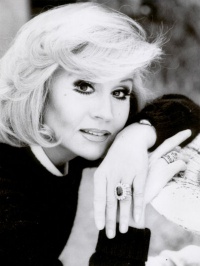Difference between revisions of "Liana Orfei"
From Circopedia
(→See Also) |
(Extensive edits throughout) |
||
| Line 4: | Line 4: | ||
| − | [[Image:Liana_Portrait_web.jpg|right|thumb|200px|Liana Orfei]]Born in 1937 | + | [[Image:Liana_Portrait_web.jpg|right|thumb|200px|Liana Orfei]]Born in Italy in 1937, the daughter of clown and circus owner [[Parise Orfei|Paride "Pippo" Orfei]] and Alba Furini, Liana Orfei began her circus career at age two, appearing as a clown. Later, she became a trapeze artist, acrobat, dancer, juggler, and a lion- and horse-trainer. In 1954, she married the juggler Angelo Piccinelli. Five years later, in 1959—without ever leaving the circus—she embarked upon a long movie career. She appeared in thirty-seven films, including Fellini's ''I Clowns'' (1972) and dozens of peplum and adventure movies. She also acted onstage under the direction of legendary playwright Eduardo De Filippo. |
| − | In 1962, with her brothers [[Nando Orfei|Nando]] and [[Rinaldo Orfei|Rinaldo]], she created her own circus, one of the first three-ring shows in Italy, titled ''Circo a 3 piste Orfei''. This became in 1970 ''Circorama'', | + | In 1962, with her brothers [[Nando Orfei|Nando]] and [[Rinaldo Orfei|Rinaldo]], she created her own circus, one of the first three-ring shows in Italy, titled ''Circo a 3 piste Orfei''. This became, in 1970, ''Circorama'', a show that included sumptuous parades as well as films projected on a cinemascope screen both between and during the acts. Liana booked some of the finest acts in the world. The circus included nearly twenty elephants, three rings of liberty horses, and a remarkable menagerie of wild and exotic animals. |
| − | + | Circorama's success led to the production ''Il Circo delle Mille e una Notte'' (The Circus of the 1001 Arabian Nights) (1973-75), an oriental circus revue that used five-hundred costumes designed by Danilo Donati (the costume designer of Federico Fellini's and Pierpaolo Pasolini's movies). This was followed in 1976 by ''Il Circo delle Amazzoni'', an all-female circus show inspired by ancient mythology. | |
| − | In 1977, the Orfei siblings split into two circuses: Nando Orfei | + | In 1977, the Orfei siblings split into two circuses: Nando Orfei created Circo Nando Orfei, while Liana and Rinaldo established a smaller but still astounding version of their Circorama (with which Liana was involved until 1984). |
| − | + | In 1978, Liana began touring as a singer in her one-woman show. She did a few recordings and hosted several TV shows. In 1975, she met the man who would become her second husband, producer Paolo Pristipino. In the late 1970s, they founded the Tendastrice concert hall in Rome. There, in 1982, they hosted the world premiere of a company from the State Circus of North Korea. In 1984, they created the [[Golden Circus Festival]], which has been held each winter in Rome. The festival celebrated its twenty-fifth anniversary in 2008. | |
==Image Gallery== | ==Image Gallery== | ||
Revision as of 04:49, 23 January 2009
Circus Director, Circus Performer, Singer, Actress
By Raffaele De Ritis
In 1962, with her brothers Nando and Rinaldo, she created her own circus, one of the first three-ring shows in Italy, titled Circo a 3 piste Orfei. This became, in 1970, Circorama, a show that included sumptuous parades as well as films projected on a cinemascope screen both between and during the acts. Liana booked some of the finest acts in the world. The circus included nearly twenty elephants, three rings of liberty"Liberty act", "Horses at liberty": Unmounted horses presented from the center of the ring by an equestrian directing his charges with his voice, body movements, and signals from a ''chambrière'' (French), or long whip. horses, and a remarkable menagerie of wild and exotic animals.
Circorama's success led to the production Il Circo delle Mille e una Notte (The Circus of the 1001 Arabian Nights) (1973-75), an oriental circus revue that used five-hundred costumes designed by Danilo Donati (the costume designer of Federico Fellini's and Pierpaolo Pasolini's movies). This was followed in 1976 by Il Circo delle Amazzoni, an all-female circus show inspired by ancient mythology.
In 1977, the Orfei siblings split into two circuses: Nando Orfei created Circo Nando Orfei, while Liana and Rinaldo established a smaller but still astounding version of their Circorama (with which Liana was involved until 1984).
In 1978, Liana began touring as a singer in her one-woman show. She did a few recordings and hosted several TV shows. In 1975, she met the man who would become her second husband, producer Paolo Pristipino. In the late 1970s, they founded the Tendastrice concert hall in Rome. There, in 1982, they hosted the world premiere of a company from the State Circus of North Korea. In 1984, they created the Golden Circus Festival, which has been held each winter in Rome. The festival celebrated its twenty-fifth anniversary in 2008.

